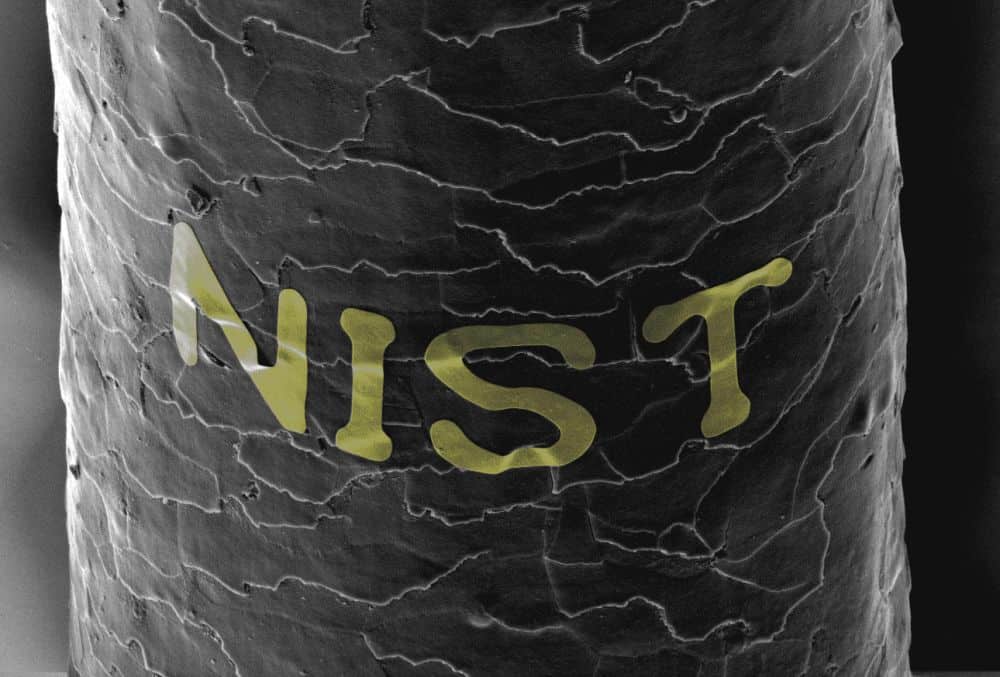
[Image above] Using sugar and corn syrup, NIST researcher Gary Zabow transferred the acronym “NIST” onto a human hair in gold letters, shown in false color in this grayscale microscope image. Credit: Gary Zabow, NIST
By Laurel Sheppard
Accidents happen, and though scientists usually try to avoid them, sometimes they result in breakthroughs. The likes of penicillin, plastic, gunpowder, shatterproof glass, and other important discoveries came about when an experiment went wrong, a mishap occurred in the lab, or a surprising discovery arose from a study with an initially different focus.
This latter situation is what happened to Gary Zabow, group leader of the Magnetic Imaging Group in the Applied Physics Division of the National Institute of Standards and Technology, when working with micromagnetic dots.
Micromagnetic dots are used as labels or tags for magnetic resonance imaging of biological cells. Zabow needed to send some of these dots to colleagues in a biomedical lab, and he found that burying them in hardened chucks of sugar served as excellent packaging material. Unlike more conventional water-soluble materials, sugar left no harmful plastics or chemicals behind when dissolved in water to free the dots upon arrival.
One day during work, Zabow found a forgotten beaker in his lab containing a leftover sugar chuck embedded with arrays of micromagnetic dots. When he dissolved the sugar and rinsed out the beaker, he found that instead of releasing into the water, the dots had transferred to the beaker’s bottom, where they cast a rainbow reflection. The colorful reflection indicated to Zabow that the arrays of microdots had retained their unique pattern.
This discovery inspired Zabow to explore if regular table sugar could be used to transfer microchips onto new and unconventional surfaces. A new microprinting process was thus born, which overcomes some challenges experienced with conventional transfer microprinting processes.
Conventional transfer processes use a solid carrier, such as flexible tapes or elastomers, or a liquid medium. Solid methods cannot conform to sharp curves nor transfer fragile structures without damage; liquid methods have limited placement accuracy.
In contrast, Zabow’s new process, called REFLEX (REflow-driven FLExible Xfer), enables “accurately positioned, ultraconformal printing over a wide array of surfaces, including those too topographically challenging to be patterned by existing methods,” he writes in a paper on the process.
The REFLEX process uses a simple combination of caramelized table sugar (sucrose) and corn syrup, which is obtained after heating with water. The corn syrup prevents crystallization, which can produce inhomogeneous surfaces.
Once the mixture is cooled, the resulting solid can be melted or redissolved in water for pouring over micropatterns or structures that are to be transferred. Any remaining water is then removed via evaporative heating.
After all water is removed, the sugar mixture hardens and can be released with the pattern embedded, sometimes by dissolving an underlying sacrificial layer. The pattern can then be redeposited on another surface by reflowing the sugar mixture, with the high reflow viscosity of the resulting fluid helping maintain the relative positions of structures during transfer.
Advantages of the REFLEX process include
- Maintaining long-range order while deforming locally
- Near room-temperature and tailorable glass transition temperatures
- Full dissolution in water, eliminating the need for harsh solvents
- Accurate positioning, with micrometer-level precision
- Eliminating resistance to both bending and stretching
- Selective release with widely available photoresists or other acetone soluble materials
- Printing over potentially unlimited surface curvatures or features with extreme sharpness
- Applicability to a wide range of materials, including metal, plastic, paper, glass, polystyrene, semiconductor, elastomer, hydrogel, and multiple biological surfaces
In his paper, Zabow used the REFLEX process to make a variety of structures, including an array of microfabricated disks, which double as reference markers, that were transferred onto a surface with recessed holes. The entire surface was patterned, including down vertical sidewalls and over edges with nanoscale radii of curvature, for both rigid and flexible microstructures.
He also printed onto the sharp point of a pin and wrote the acronym “NIST” in microscale gold lettering onto a single strand of human hair. Plus, he successfully transferred magnetic disks, 1 micrometer in diameter, onto a floss fiber of a milkweed seed. The fiber reacted in the presence of a magnet, proving successful transfer.
Zabow has filed a patent application for the new process. Future research will look at testing different sugars as well as other possible materials for encasing/transferring the micromagnetic dots and other structures. A better understanding of the process, its opportunities, and limitations is needed to fully take advantage of REFLEX and scale it up for manufacturing.
Because the REFLEX process is so inexpensive and simple, Zabow hopes many other researchers in different fields will also adopt the technology and explore what might really be possible.
Achieving peak efficiency: Improving the REFLEX process
As a new process, REFLEX may require some adjustments to achieve peak efficiency. For example, to ensure optimum spreading over a surface and to avoid dewetting of the heated mixture, it may be necessary to pretreat the surface, apply gentle pressure, or use transfer layers a few millimeters thick. Additionally, directional heating can help avoid trapping air pockets, which prevent complete pattern transfer. To accommodate locally varying surface chemistries, targeted surface pretreatments or heating profiles may offer further control.
If the transfers are not immediately redeposited on the substrates, shrinkage may occur from evaporation, distorting the transfers. Desiccator storage is one possible solution to avoid this distortion. It maintains the transfer in a stable glass state, which thus allows the submicrometer pattern to be accurately preserved for months.
“It’s really almost silly that you can transfer print onto surfaces with microscale precision using something as commonplace as a piece of candy, don’t you think?” he adds in an email.
The paper, published in Science, is “Reflow transfer for conformal three-dimensional microprinting” (DOI: 10.1126/science.add7023).
